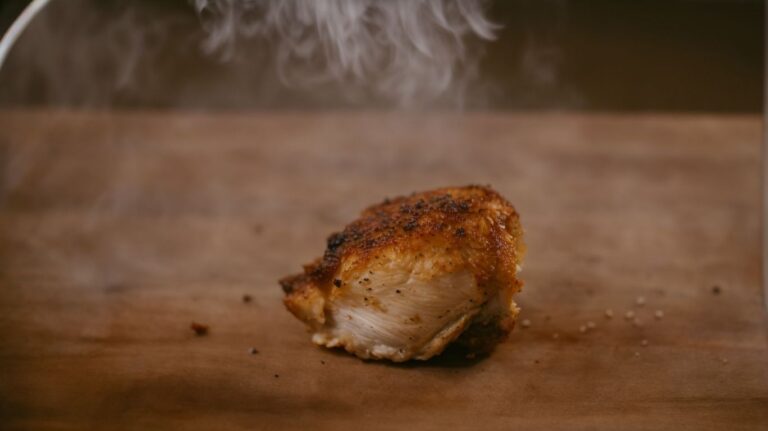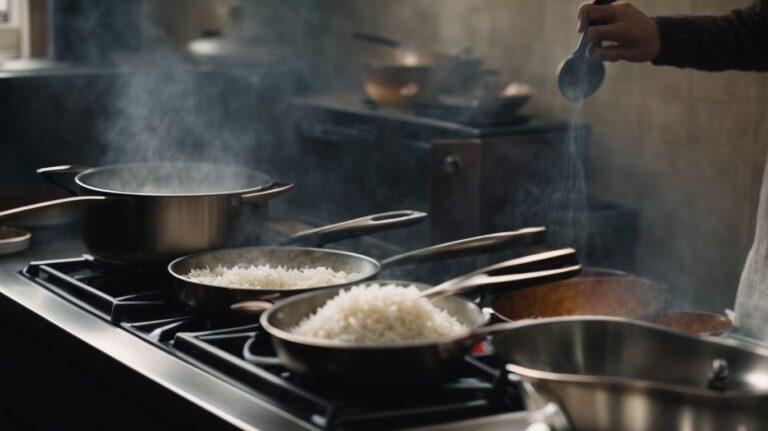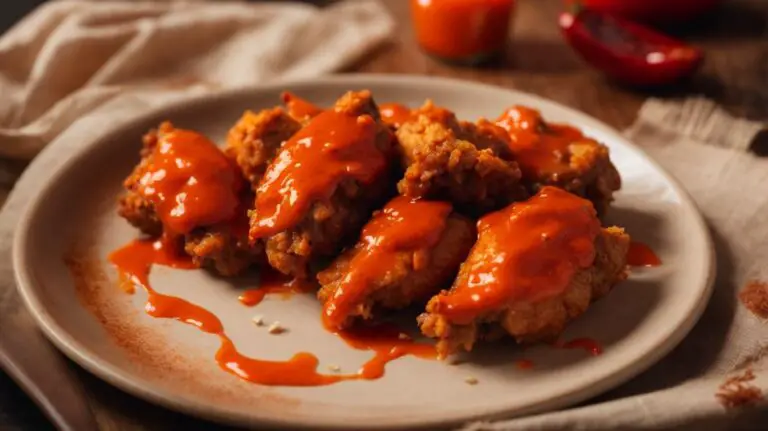How to Cook a Tomahawk Steak on Weber Q?
Have you ever wondered how to cook a mouthwatering Tomahawk Steak on a Weber Q grill?
This article explores the step-by-step process of preparing and cooking a delicious Tomahawk Steak, from thawing and seasoning to grilling and serving.
Whether you are a seasoned chef or a novice in the kitchen, this guide will provide you with all the information you need to impress your guests with a perfectly cooked Tomahawk Steak. Let’s get started!
Key Takeaways:
What is a Tomahawk Steak?
A Tomahawk Steak is a prime cut of beef known for its long bone, resembling a single-handed axe, which adds to its visual appeal and presentation on the plate.
One distinctive feature of a Tomahawk Steak is its exceptional marbling which contributes to its rich flavor and tenderness. The intricate web of fat within the meat enhances the juiciness and succulence of each bite, making it a favorite amongst steak enthusiasts. When cooking a Tomahawk Steak, the high-fat content allows for a flavorful char when seared on a hot grill, elevating its taste profile further.
To ensure your Tomahawk Steak reaches the perfect level of doneness, using a reliable meat thermometer is crucial. Whether you prefer your steak rare, medium-rare, or well-done, monitoring the internal temperature is key to achieving the desired results.
Why Use Weber Q for Cooking a Tomahawk Steak?
Utilizing a Weber Q Grill for cooking a Tomahawk Steak offers precise temperature control, even heat distribution, and convenient portability for outdoor grilling sessions.
One of the standout features of the Weber Q Grill is its ability to achieve and maintain the perfect cooking temperature with ease. Whether you prefer your steak rare, medium, or well-done, this grill allows you to adjust the heat precisely to suit your preference.
The even heat distribution of the Weber Q Grill ensures that your Tomahawk Steak cooks uniformly, preventing any undercooked or overcooked spots. This means you can enjoy a perfectly grilled steak every time, with a beautiful sear on the outside and juicy tenderness on the inside.
The portability of the Weber Q Grill makes it an ideal companion for outdoor grilling adventures. Its compact size and convenient design mean you can take it camping, to the beach, or simply enjoy a barbecue in your backyard without any hassle.
What You Will Need
To prepare a perfect Tomahawk Steak, you will require the steak itself, a Weber Q Grill for optimal cooking, a selection of seasonings and marinades, as well as essential grilling tools like Tongs and Grilling Tools.
Regarding seasoning, the quality of your ingredients can truly make a difference in the flavor profile of your steak. Opt for fresh herbs, kosher salt, cracked black pepper, and perhaps a touch of garlic powder for that savory kick. Marinades can add an extra dimension of taste, whether you prefer a classic balsamic blend or a spicy Cajun infusion.
Equally essential are the grilling tools like Tongs, which allow you to handle the steak with precision and ease. The Weber Basting Brush will help you apply marinades or sauces evenly, enhancing the juiciness and taste of the meat. Ensure your grill is preheated to the right temperature and well-oiled before cooking.
Tomahawk Steak
When selecting a Tomahawk Steak, look for prime marbling throughout the cut to ensure tenderness and flavor, and consider using a meat thermometer to monitor the steak’s internal temperature during cooking.
Another essential factor to consider when choosing the perfect Tomahawk Steak is its thickness. Opt for a steak that is at least 1.5 inches thick to ensure that it cooks evenly and retains its juiciness. Thicker cuts are also preferred as they allow for a nice sear on the outside while maintaining a perfect medium-rare or medium doneness inside.
Pay close attention to the quality indicators on the steak, such as the color and texture of the meat. Look for steaks with a vibrant red color and a good amount of fat evenly distributed throughout. This marbling not only enhances the flavor but also contributes to the steak’s juiciness and tenderness.
Weber Q Grill
The Weber Q Grill is renowned for its ability to generate high heat quickly, thanks to its advanced cooking grates design, making it ideal for searing and locking in the juices of a Tomahawk Steak.
The Weber Q Grill excels at heat retention, allowing you to cook your food evenly without excessive temperature fluctuations. Its efficient design ensures that the grill temperature remains consistent, essential for achieving that perfect sear and caramelization on your meats and vegetables.
When using the Weber Q Grill, consider leveraging indirect heat for more delicate foods or for recipes that require slower and gentler cooking. This method helps in preventing flare-ups and overcooking, resulting in perfectly grilled dishes every time.
Seasonings and Marinade
Enhance the flavor profile of your Tomahawk Steak by utilizing a blend of seasonings, marinades, and ingredients like olive oil and BBQ seasoning to create a harmonious and delicious taste experience.
Regarding seasoning your Tomahawk Steak, consider a combination of kosher salt, black pepper, garlic powder, and paprika to bring out a rich and savory taste. Allow the steak to marinate for at least 2 hours, or ideally overnight, to let the flavors penetrate the meat deeply.
For a smoky infusion, opt for wood chips in a smoker box to add complexity to the flavor profile. Experiment with different wood varieties like hickory or applewood for a unique twist on traditional grilling.
Tongs and Grilling Tools
Invest in quality Tongs and Grilling Tools, including a Weber Basting Brush, to handle and cook your Tomahawk Steak with precision, ensuring optimal flavor retention and effective basting during the grilling process.
When grilling a Tomahawk Steak, using the right tools is crucial for success. A reliable set of Tongs gives you the control needed to flip and maneuver the steak on the grill without piercing it, which can lead to loss of juices and flavor. The Weber Basting Brush, on the other hand, allows for even distribution of your marinade or oil, enhancing the taste and texture of the meat.
By using a grilling basket for smaller items like vegetables, you can prevent them from falling through the grates while still achieving that coveted char and smoky flavor. These tools not only make cooking easier but also ensure your steak is cooked to perfection, with those desirable grill marks adding an extra touch of presentation to your dish.
Preparing the Tomahawk Steak
Ahead of grilling, preparing a Tomahawk Steak involves thawing the steak to room temperature, seasoning it generously with a blend of spices, and marinating it for added depth of flavor.
Thawing a Tomahawk Steak can be done by transferring it from the freezer to the refrigerator a day before cooking. This gradual thawing process ensures even thawing and prevents any risk of bacterial growth. Once thawed, pat the steak dry with paper towels to remove excess moisture which helps in achieving a nice sear.
Regarding seasoning, a simple yet effective blend of coarse salt, black pepper, and a hint of garlic powder can enhance the meat’s natural flavors without overpowering it. Remember, the seasoning should be applied generously, ensuring that each inch of the steak is covered.
Thawing the Steak
Thawing the Tomahawk Steak properly is crucial for even cooking and optimal flavor absorption, so ensure to thaw it in the refrigerator overnight or using a cold water bath method.
When thawing in the refrigerator, place the steak in its original packaging on a plate to catch any potential drips as it thaws slowly. This method allows for a gradual thaw, reducing the risk of bacterial growth. On the other hand, the cold water bath method involves submerging the sealed steak in cold water, changing the water every 30 minutes to maintain a safe temperature.
Temperature control is key; ensure the refrigerator temperature stays below 40°F (4°C), and for the cold water bath, keep the water cold by adding ice as needed. Avoid thawing at room temperature to prevent bacteria from multiplying rapidly. Once thawed, pat the steak dry before seasoning.
Seasoning the Steak
Seasoning the Tomahawk Steak liberally with a mix of salt, pepper, and other herbs or spices enhances its natural flavors and creates a delicious crust when grilled to perfection.
For a classic steakhouse flavor, you can opt for a simple blend of kosher salt, freshly ground black pepper, and garlic powder. Alternatively, experiment with more exotic rubs featuring ingredients like smoked paprika, cumin, or dried herbs.
Customizing the seasoning mix allows you to cater to your taste preferences and introduce unique flavor profiles. When applying the seasonings, make sure to evenly coat the entire surface of the steak, gently pressing the mixture into the meat to ensure full coverage and flavor infusion. Proper use of a meat thermometer can help determine when it’s perfectly cooked to your desired level of doneness.
Marinating the Steak (Optional)
Marinating the Tomahawk Steak can infuse additional flavors and tenderize the meat, providing a depth of taste that complements the steak’s natural richness and marbling.
When considering marinating a Tomahawk Steak, the options are vast. Red wine-based marinades can bring a robust complexity, while cranberry juice infusions offer a tangy sweetness that cuts through the richness of the steak. Experimenting with different combinations of herbs, spices, and liquids can elevate the flavor profile even further.
Grilling baskets are excellent tools to ensure even cooking and prevent flare-ups while maintaining those flavorful juices. Whether marinating for just a couple of hours or overnight, the acids or enzymes in the marinade can work wonders on the meat’s texture, resulting in a juicy and tender final product.
Cooking the Tomahawk Steak on Weber Q
Cooking a Tomahawk Steak on a Weber Q Grill involves a multi-step process, starting with preheating the grill, searing the steak to lock in juices, utilizing indirect grilling for even cooking, and checking for doneness using a meat thermometer.
After preheating your grill to a medium-high temperature, around 450-500°F, it’s time to prep your steak for the sear. Season the Tomahawk Steak generously with salt and pepper before placing it directly over the hot grates. Sear each side for about 2-3 minutes to develop a beautiful crust. Once seared, you can create a two-zone fire by moving the steak to the cooler side of the grill for indirect cooking. This method allows the steak to cook evenly without burning.
For that perfect medium-rare doneness, aim for an internal temperature of around 130-135°F. Remember, the cooking time can vary depending on the thickness of the steak, so make sure to use a reliable meat thermometer to monitor the progress. While the steak rests, you can whip up a savory red wine reduction sauce to complement the rich flavors of the grilled meat.
Preheating the Grill
Before grilling the Tomahawk Steak, ensure to preheat the Weber Q Grill to the optimal temperature, allowing the grates to reach high heat levels for a perfect sear and caramelization.
Preheating your Weber Q Grill is a crucial step that sets the stage for a successful grilling experience. By preheating, you are ensuring that the entire grill surface, including the grates, is evenly heated, which is essential for achieving those beautiful sear marks on your steak.
When the grill is preheated properly, it helps in distributing the heat uniformly, ensuring that your steak cooks evenly without any cold spots. This is particularly important when cooking larger cuts of meat like a Tomahawk Steak.
Preheating the grill also aids in the flavor development process. The high heat levels help in caramelizing the surface of the steak, enhancing its taste and creating that coveted crust. To add a rich flavor, consider using Ghee instead of regular oil for grilling on your Weber Q Grill.
Searing the Steak
Searing the Tomahawk Steak on a hot grill surface creates a flavorful crust and locks in the juices, enhancing the overall taste and texture of the steak for a gourmet dining experience.
When searing your Tomahawk Steak, make sure your grill is preheated to high heat, around 450-500°F, for optimal results. This initial blast of high heat promotes the Maillard reaction, lending that coveted charred exterior.
For accurate searing, consider using a reliable thermometer like the Weber Instant-Read Thermometer to gauge the steak’s internal temperature. This precision helps you hit the sweet spot of a beautifully seared steak without overcooking.
If you prefer a more hands-off approach, devices like the Weber iGrill or Weber Connect offer remote monitoring, ensuring you nail the perfect sear while attending to other tasks.
Indirect Grilling
After searing, transition to indirect grilling on the Weber Q Grill to ensure even cooking and gentle heat exposure, allowing the Tomahawk Steak to reach the desired level of doneness without overcooking the exterior.
Indirect grilling involves using a two-zone fire setup, where the food is not directly over the flame but instead cooks through radiant heat. This method is perfect for thicker cuts like T-bone and Porterhouse steaks, allowing them to cook evenly without burning the outside. By utilizing the Weber Basting Brush to apply marinades or sauces during this phase, you enhance the flavor profile of the steak while maintaining a controlled cooking environment.
Checking for Doneness
To ensure the Tomahawk Steak is cooked to perfection, use a meat thermometer to check the internal temperature, aiming for your preferred level of doneness, whether rare, medium-rare, medium, or well-done.
Inserting the meat thermometer into the thickest part of the steak will provide you with an accurate reading of the internal temperature. For rare steak, the thermometer should show around 120°F (49°C); medium-rare 130°F (54°C); medium 140°F (60°C); and well-done above 160°F (71°C).
Once the desired internal temperature is reached, remember to let the steak rest for a few minutes before cutting into it. This resting period allows the juices to redistribute, ensuring a moist and flavorful outcome.
For enhanced flavor, consider adding wood chips to a smoker box while smoking the Tomahawk Steak. The smokiness will complement the meat’s natural flavors, adding a whole new dimension to your culinary experience.
Resting and Serving the Tomahawk Steak
Allow the Tomahawk Steak to rest after cooking to redistribute the juices for optimal tenderness, then carve and serve the steak to showcase its succulent flavors and complement it with your favorite sides and sauces.
Resting the steak for about 10-15 minutes under a loose foil tent is crucial before carving to let the juices settle and ensure a moist bite every time.
When you’re ready to carve, use Weber Tongs to handle the large cut of meat, making clean and precise slices against the bone for those perfect medallions.
Consider serving the steak on a wooden board surrounded by roasted seasonal vegetables for a rustic and inviting presentation that pairs wonderfully with a bold red wine.
Resting the Steak
Resting the Tomahawk Steak post-cooking allows the juices to redistribute evenly, enhancing the steak’s tenderness and juiciness for a more enjoyable dining experience.
When you grill a Tomahawk Steak to the perfect temperature on your Weber Sear Grate, those intense flavors are locked in during the cooking process. By letting it rest before slicing into it, you are giving the meat fibers a chance to relax and reabsorb some of those flavorful juices. This process not only enhances the overall taste but also ensures that each bite is tender and succulent.
Carving and Serving the Steak
When carving and serving the Tomahawk Steak, pay attention to the bone-in presentation, slice against the grain for optimal tenderness, and pair the steak with complementary foods, sauces, and flavors to elevate the dining experience.
One essential aspect to consider when preparing a Tomahawk Steak is the cooking method chosen, as the smoky flavor from charcoal grilling can enhance the overall taste profile of the steak. Charcoal imparts a unique flavor that adds a depth to the meat, providing a delicious contrast to the rich marbling of the steak. Remember to allow the steak to rest before carving to retain its juiciness, ensuring each slice is succulent and bursting with flavor.
Frequently Asked Questions
Can I cook a Tomahawk steak on a Weber Q grill?
Yes, you can! In fact, a Weber Q grill is a great choice for cooking a Tomahawk steak because of its high heat output and even cooking surface.
What is a Tomahawk steak and how is it different from a regular steak?
A Tomahawk steak is a thick cut of ribeye steak that includes the entire rib bone, resembling a tomahawk axe. It is larger and more flavorful than a regular steak, making it a popular choice for special occasions.
Should I marinate my Tomahawk steak before cooking it on a Weber Q?
It is not necessary to marinate a Tomahawk steak before cooking it on a Weber Q. This type of steak is already very flavorful and a simple seasoning with salt and pepper is all you need.
How do I achieve the perfect level of doneness when cooking a Tomahawk steak on a Weber Q?
The best way to achieve the perfect level of doneness is by using a meat thermometer. For a medium-rare steak, aim for an internal temperature of 130-135°F, and for medium, aim for 140-145°F.
How long should I let my Tomahawk steak rest before slicing and serving?
It is important to let your Tomahawk steak rest for about 10 minutes after cooking. This allows the juices to redistribute, making for a more tender and flavorful steak.
Can I cook a Tomahawk steak on a Weber Q if it’s frozen?
It is not recommended to cook a frozen Tomahawk steak on a Weber Q. The steak will cook unevenly and may result in a tough and dry texture. It is best to thaw the steak in the refrigerator before cooking.



